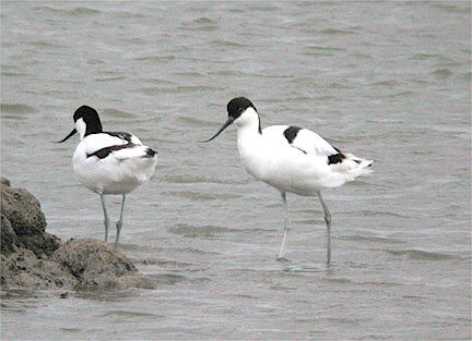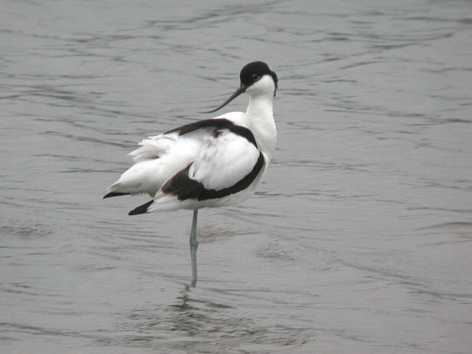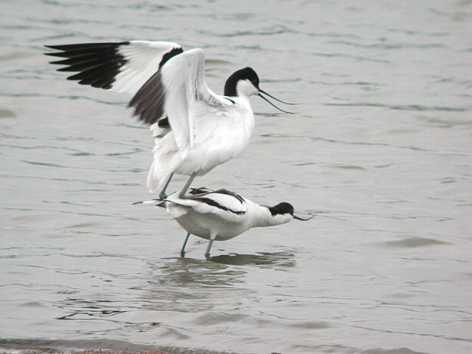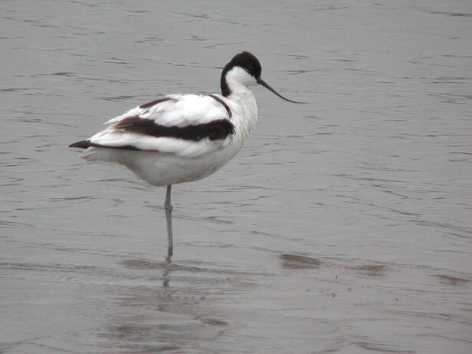|
In the spring of 2003 a pair of avocets established territory, laid four eggs and successfully fledged four young at the Worcestershire Wildlife Trust reserve at Upton Warren. It was of course not quite as simple as that. Avocets have occurred as passage migrants at Upton Warren and at a few other sites in the county on several occasions in recent years but none have shown signs of remaining to breed. In March 2003 a single bird appeared and stayed for a few days before departing in the time-honoured manner. However on 19th April a pair arrived at the Flash Pools and immediately showed signs of establishing territory: courtship, mating and nest construction on one of the shingle islands. The first of a clutch of four eggs was laid on 27th of April with the second on the 28th, the third on the 30th with full time incubation by both male and female also commencing on this date. The final egg was laid on the 2nd of May. Three young hatched during the early hours of 23rd May and by late afternoon of that day all three chicks were led off the nesting island to the mainland by the male, the female remaining incubating the final egg which eventually hatched on the 25th of May. The young proceeded to grow at what seemed an amazing rate with all four youngsters flying by 20th of June. The male departed on 2nd of July, the female and 4 young on 13th July. Throughout the egg laying and incubation period a 24-hour guard of the nest was kept with help from both paid and unpaid volunteers together with Wildlife Trust staff. Fortunately a fox proof fence had been erected during the previous year and although foxes did manage to enter the site on a couple of occasions they were chased out by the ever vigilant volunteers before being able to cause too much disturbance. Avocets are highly aggressive defenders of both territory and young and the pair engaged regularly with grey herons, Canada geese, coot, moorhen, gulls, assorted corvids and raptors. They were however more tolerant of other wader species present, plus their chicks. Avocets became extinct as a breeding species in Britain in 1842. The collecting of both eggs and specimens may have been responsible for this temporary extinction. Recolonisation of eastern England began in the early 1940’s, when public access to coastal areas was restricted and the breaching of sea walls for defence purposes created shallow brackish lagoons. Avocets favour this habitat type with its bare or sparsely vegetated margins and islands. The saline nature of Upton Warren Flash Pools (due to seepage from underground salt deposits) emulates these coastal conditions, with bare mud, sparse salt marsh vegetation and a lack of the tall riparian plants usually associated with inland wetland sites.
Breeding numbers both in the UK and in continental Europe have increased since the mid 1970’s with the main UK population being concentrated on the coasts of East Anglia and North Kent. By 2000 the UK breeding population had increased to almost 1000 pairs. Reduction in human disturbance and appropriate habitat management at key breeding sites thought to be the main reasons for this increase. Similarly, a large increase also occurred in The Netherlands, where the breeding population doubled in 15 years, probably as a result of eutrophication in the Wadden Sea, which increased food supply, and the creation of artificial breeding sites in the Delta area. It is likely that the considerable population growth and range expansion witnessed in England has been supplemented by immigration from The Netherlands and Denmark, where large increases were also noted during the same period. Research has shown that pairs breeding at newly colonised sites have a higher level of productivity than those at established sites, where occupancy of breeding habitat has reached ‘pair carrying capacity’. The 1000 breeding pairs in England in the year 2000 produced only 172 young. This process is likely to stimulate continuing range expansion and possibly the use of alternative breeding habitat. Avocets normally breed for the first time at two years old, often at a different location from where they themselves were reared, but having bred successfully they will be faithful to the site in subsequent years. Therefore if the adults survive the winter we may witness their return next year. To put the Worcestershire record into context, in recent years inland breeding attempts by avocets have occurred in the London area, at Rutland Water and on the Ouse Washes, all of them being unsuccessful. We can therefore safely say that our record is the first successful inland breeding of avocets in the British Isles. Coincidentally, the first record of avocets breeding in Wales occurred at the Gwent Levels Wetland Reserve at Goldcliff this year. As with the Worcestershire birds a single pair laid four eggs and four young successfully fledged, but this is of course a coastal site! Many thanks to Andy Warr for supplying information and to all those would guarded and enjoyed Worcestershire Avocets in 2003. References OGILVIE, M.A. 2003. Rare Breeding Birds in the United Kingdom in 2001. British
Birds 96:476-519. The following web sites contain useful information: www.jncc.gov.uk/ukspa/species/accounts/a6-57a.pdf www.jncc.gov.uk/ukspa/species/accounts/a6-57b.pdf
|
 |
 |
|
 |
|
 |